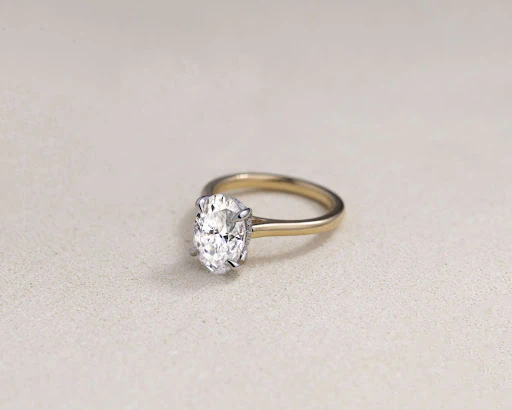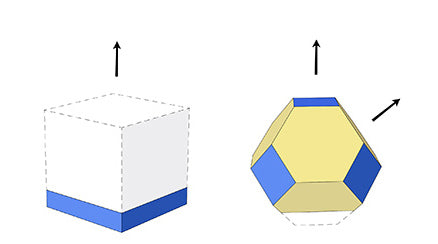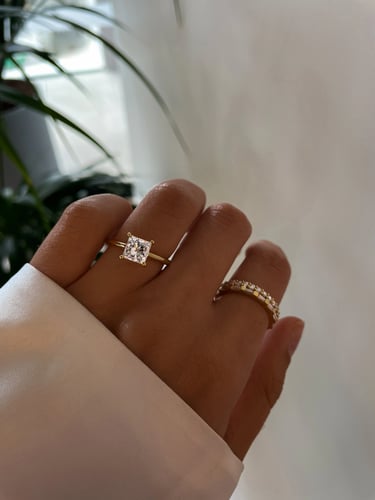
When it comes to real diamonds, there are two types: lab grown diamonds and traditional mined diamonds. One of the main advantages of lab grown diamonds is that they are more environmentally friendly than mined diamonds. Diamond mining negatively impacts the environment, causing soil erosion, water pollution, and habitat destruction. On the other hand, lab grown diamonds are produced in a controlled environment with minimal environmental impact.
In addition, lab grown diamonds are often less expensive than mined diamonds, making them a more affordable option for many consumers. And because they are grown in a laboratory under the recreated conditions of nature, lab grown diamonds are measured by the same 4Cs: colour, clarity, and carat weight.
Lab grown diamonds are created in a laboratory instead of mined from the ground. Despite their differing origins, they are real diamonds that are optically identical to mined diamonds. The two primary methods of growing diamonds are chemical vapour deposition (CVD) and high-pressure high-temperature (HPHT). In this blog post, we will compare CVD and HPHT diamonds to ensure you’re better informed when buying diamonds online.
Chemical Vapour Deposition (CVD)
For centuries, diamonds have been revered for their beauty and toughness. These qualities result from the unique way diamonds are formed under extreme heat and pressure deep within the Earth's mantle. However, this has led to severe exploitation in the form of costly diamond mines. Fortunately, it is possible to create diamonds in a lab using chemical vapour deposition (CVD).

To create a CVD diamond, a small, typically lab grown diamond seed is placed in a chamber and exposed to a carbon-rich gas, such as methane. A plasma torch breaks down the gases and the resulting carbon atoms settle on the surface of the seed crystal, gradually building up a layer of diamond. A useful metaphor is when snowflakes collect on the ground and are then compressed to make snow. The result with CVD is a lab created diamond that has "this Laboratory Grown Diamond was created by chemical vapour deposition (CVD) growth process" written on its International Gemological Institute (IGI) gem certification.
The CVD process is a popular way to create a lab grown diamond. CVD diamonds are often used in industrial applications as they can withstand high temperatures and extreme wear and tear. However, the CVD method is also increasingly being used to create gem-quality diamonds for jewellery purposes. Thanks to technological advances, these diamonds are indistinguishable from mined diamonds with the naked eye and are becoming more affordable for consumers.
High Pressure, High Temperature (HPHT)
For many, diamonds symbolise love and commitment and are thus chosen for stunning engagement rings. However, these precious gems are not formed in the same way as other minerals, such as moissanite. Instead, a mined diamond is created deep within the Earth under exceptionally high pressure and temperature conditions.

This process is replicated to create a lab grown diamond through cutting-edge technology known as HPHT. Scientists start with a small piece of pure carbon to create an HPHT diamond. This carbon is then placed inside a chamber that is subjected to extreme pressure and heat (generally around 5.0–6.5 GPa and 1300–1700°C) via one of three manufacturing methods: a belt press, cubic press, or split-sphere (BARS) press. Over time, the carbon slowly transforms into a lab grown diamond. The resulting rough diamond is then cut and polished to create a beautiful piece of jewellery.
The HPHT method was first developed in the 1950s and has been used commercially since the early 21st century. While the HPHT method may sound simple, it actually requires niche expertise and expensive equipment. As a result, only a handful of companies are able to produce diamonds using this method, with CVD becoming more prominent due to how it makes the same quality diamonds but through moderate temperatures and low pressures.
The CVD and HPHT Methods Are Similar
CVD and HPHT methods are both used to create lab grown diamonds. The two approaches are very similar, and both involve using temperature and pressure to compress carbon into a diamond structure. Additionally, both produce a lab grown diamond that is much more affordable than a mined diamond and can be created in a wide range of colours and carat weights. As a result, they are an excellent choice for couples who want the perfect diamond for an engagement ring without the high price tag.

However, there are some key differences between the two processes. For example, a CVD diamond is grown from a gaseous carbon source, while HPHT diamonds are created by compressing carbon powder under extremely high pressure. In addition, while CVD diamonds grow in a cubic shape and have only one growth direction, HPHT diamonds grow in a cuboctahedron shape and have 14 growth directions. Finally, the CVD method tends to produce diamonds that have fewer inclusions and higher clarity and colour grades than HPHT as it does not involve metal. However, despite these differences, CVD and HPHT diamonds are equally valuable and are identical if they have matching colour and clarity grades.

Conclusion
Few things are as associated with love and luxury as diamonds. With lab created diamonds, more people can buy a stunning real diamond with the same optical characteristics as a mined diamond.
The CVD method involves depositing carbon-rich gases, the same material as a mined diamond, onto a substrate, namely a lab grown diamond seed. The carbon slowly builds up over time, creating full-sized CVD diamonds.
The HPHT method is a process that mimics the conditions deep within the earth that are necessary for diamond formation. By subjecting a carbon-rich material to extreme pressure and heat with a metal catalyst, it is possible to create beautiful HPHT diamonds.
Ultimately, both methods of creating diamonds are similar, with the main difference being the temperature and pressure used in the process. It is essential to note that no two diamonds are the same, whether an earth mined diamond or a lab created diamond.
Nevertheless, lab grown diamonds are chemically identical to those created by the earth, but they come at a fraction of the price — which is why lab grown diamonds are so popular. Now that you know more about them, check out Cullen Jewellery's excellent lab grown diamond display!
In the past few years, lab grown diamonds have made a big splash in the jewellery industry.
More and more couples are choosing lab grown diamonds for their engagement and wedding rings, and it's not hard to see why.
These diamonds are environmentally friendly, ethically sourced, and just as sparkly as mined diamonds—but often at a fraction of the price. In fact, because they are grown under controlled conditions, they often have superior clarity and colour. Here are 3 detailed reasons why lab grown diamonds are better:
1. Environmentally Friendly
One of the biggest selling points of lab grown diamonds is that they are much more environmentally friendly than mined diamonds.
The process of mining diamonds can be very harmful to the environment, causing water pollution, soil erosion, deforestation, contamination and alteration of soil profiles, and habitat destruction.
Lab grown diamonds don't have any of these negative impacts because they are grown in a controlled laboratory setting. Additionally, lab grown diamonds use significantly less energy than mined diamonds.
2. Ethically Sourced
Another big selling point of lab grown diamonds is that they are ethically sourced. The diamond mining industry has been plagued by reports of human rights abuses, child labour, and conflict diamonds (diamonds that are mined in war zones and used to fund rebel groups).
So when you choose lab created diamonds, you can be sure that it wasn't mined under unethical or dangerous conditions.
3. Same Chemical Makeup at A Lower Price
Lab created diamonds are the same as mined diamonds chemically — and more affordable. So when it comes to quality, there is no difference between a lab grown diamond and a mined diamond.
Both types of diamonds are made of carbon atoms arranged in a lattice structure—the only difference is how they were created. In fact, most people can't tell the difference between a lab grown diamond and a mined diamond with the naked eye.
The only way to tell them apart is with specialised equipment like thermal conductivity meters or ultraviolet fluorescence scanners.
Or price. On average, lab grown diamonds cost 30-70% less than their mined counterparts.
So, if you're working with a tight budget but still want the beauty of a diamond without the ethical baggage, then a lab grown diamond is the way to go.
If you're in the market for a new piece of diamond jewellery, consider choosing a lab grown diamond instead of a mined one. These diamonds are just as beautiful and sparkling as their mined counterparts but are much more environmentally friendly and ethically sourced.
Cullen Jewellery only sells lab grown, conflict-free diamonds, so you can be sure your purchase is not contributing to human rights abuses or environmental destruction.
In addition, Cullen Jewellery offers a wide variety of lab grown diamonds at competitive prices. So why not choose a new diamond grown in a lab from Cullen Jewellery and help make the world a better place? Start shopping for your perfect lab grown diamond today!
